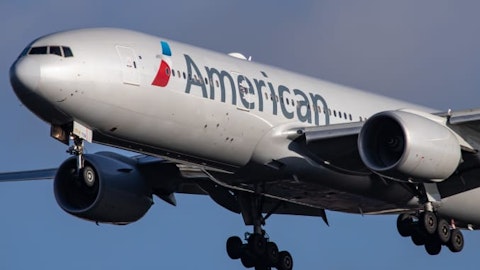Duane Pfennigwerth: That’s all great. And just my follow-up. Any outlook or update you can provide us, your outlook for new wins in the cargo segment? Thanks for taking the questions.
Jude Bricker: Nothing to talk about right now.
David Davis: Yeah, we probably don’t have much to talk about at this point.
Duane Pfennigwerth: Okay. Thank you.
Operator: Your next question comes from Helane Becker with TD Cowen
Helane Becker: Thanks very much, operator. Hi, team. Thanks for the time. Just a couple of clarification points. Are you expecting maintenance costs then to continue to be at this level for the rest of the year or is this just a one-quarter event?
David Davis: No, the maintenance costs are going to stay a bit elevated like this through the rest of the year. I think we talked about it on the Q1 or the call we get in the end of ’23, about some intentional changes to our maintenance program that we made in ’24 that are going to keep costs higher. And that’s going to likely persist, or it will persist based on our plan through ’24.
Helane Becker: Okay. That’s very helpful. Thanks, Dave. And then the other question I have is with respect to the decline in air traffic liability. And maybe you explained it through the changes in bookings, but usually it doesn’t decline as much as it seems to have declined from the year end, from the fourth quarter to the first quarter. But it was down 24%. So how are you thinking about that? Or did you explain that already?
David Davis: I don’t think we explained it already, but I mean the ATL is going to drop as we go through Q1. A little bit of the decline this time, what might be the weaker fare environment in the second quarter. But there’s nothing unusual in the ATL drop.
Helane Becker: Okay. Well, that’s very helpful.
Jude Bricker: Yeah. Just there is a lot of seasonality in our ATL just based on the volatility of our schedule and fare environment. So going into the first quarter, we’ll have the highest ATLs for the year.
Helane Becker: Right, that’s what I would expect. But I wouldn’t expect it to decline as much as it did from January to March. But I guess it all has to do with not having as many bookings for the second quarter, the Easter shift, and all the other things you’ve already explained, right? Is that how we should sort of think about it?
David Davis: Yeah. To the extent that it’s a little bit unusually large, it would be the fair issues you’re talking about, and Easter is a big part of it.
Operator: Your next question comes from Michael Linenberg with Deutsche Bank.
Michael Linenberg: Hey, good morning, everyone. In the release, and I think Jude, you even sort of mentioned capacity by competitors, OA capacity. Can you give us a sense of maybe what OA capacity looks in the June quarter in your markets, year over year changes made in September. Maybe how that trends? Maybe it was better in the March quarter? Any color on that would be great.
Jude Bricker: Domestic capacity was up 6% and overlay capacity was up about 10% in the first quarter. Those trends are basically consistent in the second quarter as well. Keep in mind, our network is dramatically different from quarter to those two quarters. But I mean, we’re just seeing a lot of seats in our markets. In the back of the year, we become really concentrated between Labor Day and Thanksgiving because as we trim our markets that are seasonal, so that’s where the concentration resides. So then we have a lot of capacity into major trunk routes out of Minneapolis, and that’s where you see a lot of — see pressure.
Michael Linenberg: Okay. And then just my second question is you’ve obviously identified the issue and you’ll respond. As you mentioned in sort of the off-peak periods from September through Thanksgiving. How much of what’s going on reflects some of the other churn going on in the industry? When I think about the network changes being made by many of the other carriers. And I would say it’s really the smaller carriers, not the big three. I mean, they’re very well established. The churn that we’re seeing in network changes. It’s quite frankly, it’s nothing like I’ve seen before when I look at the number of additions and deletions. And so how much of this may be just more of this sort of structural change going on in the industry? Where it just may be that more difficult to respond to because of the dramatic shifts in networks that we’re seeing? Just your thoughts on that, thanks.
Jude Bricker: It’s difficult to give a long-term read-through based on a very limited amount of input. I mean, my view would be that Spirit and Frontier are challenged more with when they fly than where they fly. The same way that we’re having these off-peak weaknesses, they’re experiencing the same. And so the network churn isn’t addressing the issue. Our response to this is going to be looking at incremental capacity and shave it down, and it always has been. And then on a competitive encroachment, most of what we’re seeing is from Delta, quite frankly. And it seems like they’re just kind of building out Minneapolis in the post-COVID recovery, later than they’ve done in some of their other hubs. And then there has been some encroachment speaking specifically of Minneapolis from Frontier.
But those markets like Cleveland, are ones that they had done pre-COVID and cancelled because they didn’t work. So I don’t — I think it’s mainly just, our markets had really high fares through the comp period that people are scheduling into, and they attracted a bunch of seats and it’ll sort of equivocate over time.




